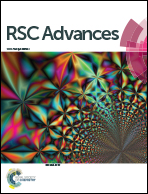Synthesis of biologically important, fluorescence active 5-hydroxy benzo[g]indoles through four-component domino condensations and their fluorescence “Turn-off” sensing of Fe(iii) ions†
Abstract
Several highly substituted 2-pyrrolyl-2-cyanoacetamides were prepared through four-component domino condensation of various easily available 1,3-dicarbonyl compounds, amines, arylglyoxals and malononitrile. Subsequently these cyanoacetamide derivatives were converted into biologically important 5-hydroxy benzo[g]indoles through thermal cyclization under metal-free conditions. The synthesized 5-hydroxy benzo[g]indoles are fluorescence active with good quantum yields (ΦF = ∼0.50). They also show excellent fluorescence “Turn-off” sensing of Fe3+ ions (detection limit = ∼1.2 × 10−6 M). The interaction of 5-hydroxy benzo[g]indoles with Fe3+ ions can also be monitored through UV-Vis spectral change and naked-eye colour change in the presence and absence of UV radiation. The 1H NMR titration unambiguously proves the formation of a complex between 5-hydroxy benzo[g]indoles and Fe3+ ion through the coordination of –OH groups with the metal. The binding constant of the complex (metal : ligand = 1 : 1) has been measured using Benesi–Hildebrand equation and found to be ∼7.97 × 103 M−1.
![Graphical abstract: Synthesis of biologically important, fluorescence active 5-hydroxy benzo[g]indoles through four-component domino condensations and their fluorescence “Turn-off” sensing of Fe(iii) ions](/en/Image/Get?imageInfo.ImageType=GA&imageInfo.ImageIdentifier.ManuscriptID=C5RA05780A&imageInfo.ImageIdentifier.Year=2015)

 Please wait while we load your content...
Please wait while we load your content...